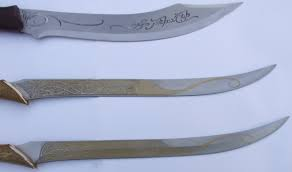The Elven Warrior Sword: Elegance, Power, and Mythical Craftsmanship
The Elven Warrior Sword is a symbol of elegance, power, and ancient craftsmanship in Middle-Earth. Elves, known for their sharp senses and magical abilities, create these elegant and deadly swords. These swords are well-made and often stay sharp for thousands of years. This introduction explores the unique features and history of the Elven Warrior Sword, a masterpiece in fantasy weaponry.
A History Steeped in Myth and Magic
The original beginnings of the Elven warrior sword are lost to time. Written records of Elven society mostly come before it, and oral tradition keeps its history. Various fantasy worlds share similar stories about the sword's origins. One story suggests Elven swordsmiths learned from powerful beings called the Valar, adding enchantments that channel starlight and moonlight. Another theory says Elven blades were made from rare metals deep within the earth, holding the life force of nature.
Design: A Marriage of Form and Function
Elven warrior swords are well-designed and appealing. The blades are long, sharp, and often have a U-shaped profile for nimble movements. They're sometimes made from mithril, a strong yet light metal, allowing Elves to use them as shields. The hilts feature intricate carvings of leaves, vines, and flowers, sometimes with runes or enchantments to enhance their magic. The guards protect the wielder's hand, shaped like flowing, organic forms to connect with nature.
Cultural Significance: Beyond the Battlefield
Elven warrior swords are more than weapons; they're cultural symbols. They represent Elven values like grace, precision, and harmony with nature. Owning such a sword shows honor and skill in Elven society. Passed down through generations, these swords carry family history, often with designs showing family crests or victories. During peace, Elves proudly display these swords in homes and halls, reminders of their heritage and defense of their lands.
Beyond Tolkien: Elven Swords in Fantasy Literature
The Elven warrior sword is popularized by J.R.R. Tolkien's Lord of the Rings but appears in many fantasy stories with unique traits reflecting different Elven cultures. In Dragonlance, Elven blades hold dragon spirits for power. In Elder Scrolls, they're known for sharp edges and draining enemies' life force. Each story adds its own creativity while keeping the sword's core design principles.
The Allure of the Elven Warrior Sword
The Elven warrior sword remains a captivating symbol in fantasy for readers and fans. It represents the balance of beauty and danger in Elven culture, both elegant and deadly. Creating such a weapon requires great skill and effort, highlighting Elven artistry and craftsmanship. Whether wielded by an armored knight or a nimble ranger, the Elven warrior sword always signifies elegance, strength, and protection of the magical realms.

Comments
Post a Comment